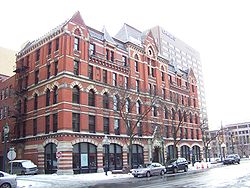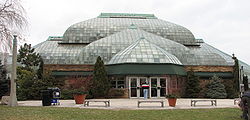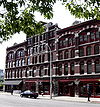
Joseph Lyman Silsbee
Encyclopedia


United States
The United States of America is a federal constitutional republic comprising fifty states and a federal district...
architect
Architect
An architect is a person trained in the planning, design and oversight of the construction of buildings. To practice architecture means to offer or render services in connection with the design and construction of a building, or group of buildings and the space within the site surrounding the...
during the 19th and 20th centuries. He was well known for his facility of drawing and gift for designing buildings in a variety of styles.his most prominent works ran through Syracuse, Buffalo and Chicago He was influential as mentor to a generation of architects, most notably architects of the Prairie School
Prairie School
Prairie School was a late 19th and early 20th century architectural style, most common to the Midwestern United States.The works of the Prairie School architects are usually marked by horizontal lines, flat or hipped roofs with broad overhanging eaves, windows grouped in horizontal bands,...
including the famous architect Frank Lloyd Wright
Frank Lloyd Wright
Frank Lloyd Wright was an American architect, interior designer, writer and educator, who designed more than 1,000 structures and completed 500 works. Wright believed in designing structures which were in harmony with humanity and its environment, a philosophy he called organic architecture...
.
Biography
Born in 1848 at SalemSalem, Massachusetts
Salem is a city in Essex County, Massachusetts, United States. The population was 40,407 at the 2000 census. It and Lawrence are the county seats of Essex County...
, Massachusetts
Massachusetts
The Commonwealth of Massachusetts is a state in the New England region of the northeastern United States of America. It is bordered by Rhode Island and Connecticut to the south, New York to the west, and Vermont and New Hampshire to the north; at its east lies the Atlantic Ocean. As of the 2010...
, Joseph Lyman Silsbee graduated from Phillips Exeter Academy
Phillips Exeter Academy
Phillips Exeter Academy is a private secondary school located in Exeter, New Hampshire, in the United States.Exeter is noted for its application of Harkness education, a system based on a conference format of teacher and student interaction, similar to the Socratic method of learning through asking...
and Harvard. He then became an early student of the first school of architecture in the United States, the Massachusetts Institute of Technology
Massachusetts Institute of Technology
The Massachusetts Institute of Technology is a private research university located in Cambridge, Massachusetts. MIT has five schools and one college, containing a total of 32 academic departments, with a strong emphasis on scientific and technological education and research.Founded in 1861 in...
. Thereafter he served an apprenticeship with Boston
Boston
Boston is the capital of and largest city in Massachusetts, and is one of the oldest cities in the United States. The largest city in New England, Boston is regarded as the unofficial "Capital of New England" for its economic and cultural impact on the entire New England region. The city proper had...
architects Ware & Van Brundt and William Ralph Emerson
William Ralph Emerson
-Biography:Emerson was born in Alton, Illinois, a cousin of Ralph Waldo Emerson, and trained in the office of Jonathan Preston , an architect–builder in Boston, Massachusetts. He formed an architectural partnership with Preston , practiced alone for two years, then partnered with Carl Fehmer...
, respectively. Silsbee traveled in Europe
Europe
Europe is, by convention, one of the world's seven continents. Comprising the westernmost peninsula of Eurasia, Europe is generally 'divided' from Asia to its east by the watershed divides of the Ural and Caucasus Mountains, the Ural River, the Caspian and Black Seas, and the waterways connecting...
before moving to Syracuse
Syracuse, New York
Syracuse is a city in and the county seat of Onondaga County, New York, United States, the largest U.S. city with the name "Syracuse", and the fifth most populous city in the state. At the 2010 census, the city population was 145,170, and its metropolitan area had a population of 742,603...
, New York
New York
New York is a state in the Northeastern region of the United States. It is the nation's third most populous state. New York is bordered by New Jersey and Pennsylvania to the south, and by Connecticut, Massachusetts and Vermont to the east...
in 1874. In 1875 he married Anna Baldwin Sedgwick, daughter of influential lawyer and politician Charles Baldwin Sedgwick
Charles B. Sedgwick
Charles Baldwin Sedgwick was a U.S. Representative from New York during the American Civil War.-Biography:Sedgwick was born in Pompey, New York, and attended Pompey Hill Academy, and Hamilton College, Clinton, New York...
.
Silsbee practiced architecture from 1875 until his death in 1913. He had a prolific practice and at one point had three simultaneously operating offices. He had offices in Syracuse (1875–1885), Buffalo
Buffalo, New York
Buffalo is the second most populous city in the state of New York, after New York City. Located in Western New York on the eastern shores of Lake Erie and at the head of the Niagara River across from Fort Erie, Ontario, Buffalo is the seat of Erie County and the principal city of the...
(Silsbee & Marling, 1882–1887), and Chicago
Chicago
Chicago is the largest city in the US state of Illinois. With nearly 2.7 million residents, it is the most populous city in the Midwestern United States and the third most populous in the US, after New York City and Los Angeles...
(Silsbee and Kent, 1883–1884). From 1883–1885 his Syracuse office was a partnership with architect Ellis G. Hall. Silsbee's Chicago office had a number of architects who were later to become known in their own right, including: Frank Lloyd Wright
Frank Lloyd Wright
Frank Lloyd Wright was an American architect, interior designer, writer and educator, who designed more than 1,000 structures and completed 500 works. Wright believed in designing structures which were in harmony with humanity and its environment, a philosophy he called organic architecture...
, George Grant Elmslie
George Grant Elmslie
George Grant Elmslie was an American, though born in Aberdeenshire, Scotland, Prairie School architect whose work is mostly found in the Midwestern United States...
, George W. Maher
George W. Maher
George Washington Maher was a significant contributor to the Prairie School-style of architecture during the first-quarter of the 20th century. He also was known for blending the traditional with the Arts & Crafts-style. According to architectural historian H...
, and Irving Gill
Irving Gill
Irving John Gill , American architect, is considered a pioneer of the modern movement in architecture. He designed several buildings considered examples of San Diego's best architecture.-Biography:...
.
Silsbee was one of the first professors of architecture at Syracuse University
Syracuse University
Syracuse University is a private research university located in Syracuse, New York, United States. Its roots can be traced back to Genesee Wesleyan Seminary, founded by the Methodist Episcopal Church in 1832, which also later founded Genesee College...
, one of the earliest schools of architecture in the nation. He was a founding member of the Chicago and Illinois Chapters of the American Institute of Architects
American Institute of Architects
The American Institute of Architects is a professional organization for architects in the United States. Headquartered in Washington, D.C., the AIA offers education, government advocacy, community redevelopment, and public outreach to support the architecture profession and improve its public image...
. In 1894 Silsbee was awarded the Peabody Medal by the Franklin Institute
Franklin Institute
The Franklin Institute is a museum in Philadelphia, Pennsylvania, and one of the oldest centers of science education and development in the United States, dating to 1824. The Institute also houses the Benjamin Franklin National Memorial.-History:On February 5, 1824, Samuel Vaughn Merrick and...
for his design for a Moving Sidewalk. This invention had its debut at the Worlds Columbian Exposition and saw usage in subsequent Worlds Fairs.
Architecture


Syracuse Savings Bank Building
Syracuse Savings Bank Building, also known as Bank of America building, is a historic building in Syracuse, New York designed by Joseph Lyman Silsbee, then aged 26....
(1876). Built next to the Erie Canal
Erie Canal
The Erie Canal is a waterway in New York that runs about from Albany, New York, on the Hudson River to Buffalo, New York, at Lake Erie, completing a navigable water route from the Atlantic Ocean to the Great Lakes. The canal contains 36 locks and encompasses a total elevation differential of...
on Clinton Square in Syracuse, it is often referred to as a textbook example of the High Victorian Gothic
Gothic Revival architecture
The Gothic Revival is an architectural movement that began in the 1740s in England...
style. Silsbee also designed the White Memorial Building (1876), the Amos Block
Amos Block
The Amos Block is a Romanesque Revival building located on the southwest corner of Clinton Square in Downtown Syracuse, New York. The building's developer and namesake, Jacob Amos, served as mayor of Syracuse from 1892-1896...
(1878), and the Oakwood Cemetery Chapel (1879–80), all extant in Syracuse. Upland Farm (1892), the lost mansion designed for Frederick R. and Dora Sedgwick Hazard in nearby Solvay
Solvay, New York
Solvay is a village located in Onondaga County, New York, and a suburb of the city of Syracuse. According to the 2000 census, the village had a total population of 6,845...
, New York is an example of the fashionable residential work that Silsbee was best known for. Photographs of these works are linked below. Silsbee designed the lavish interiors of Potter Palmer
Potter Palmer
Potter Palmer was an American businessman who was responsible for much of the development of State Street in Chicago.-Retailing career:...
's "castle" in Chicago. Several of his residential designs survive in Riverside
Riverside, Illinois
Riverside is an affluent suburban village in Cook County, Illinois. A significant portion of the village is in the Riverside Landscape Architecture District, designated a National Historic Landmark in 1970. The population was 8,895 at the 2000 census...
, Illinois
Illinois
Illinois is the fifth-most populous state of the United States of America, and is often noted for being a microcosm of the entire country. With Chicago in the northeast, small industrial cities and great agricultural productivity in central and northern Illinois, and natural resources like coal,...
. His most prominent surviving work in Chicago is the Lincoln Park Conservatory
Lincoln Park Conservatory
The Lincoln Park Conservatory is a conservatory and botanical garden in Lincoln Park in Chicago, Illinois. The conservatory is situated at 2391 North Stockton Drive just south of Fullerton Avenue, west of Lake Shore Drive, and part of the Lincoln Park, Chicago community area. Positioned near the...
.

